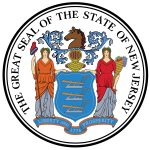New Jersey at-large
4 seats on a general ticket | Pro-Administration win | - ▌
 Y James Schureman (Pro-Admin.) 19.93% (13,871 votes) Y James Schureman (Pro-Admin.) 19.93% (13,871 votes) - ▌
 Y Elias Boudinot (Pro-Admin.) 13.00% (9,051 votes) Y Elias Boudinot (Pro-Admin.) 13.00% (9,051 votes) - ▌
 Y Lambert Cadwalader (Pro-Admin.) 12.50% (8,702 votes) Y Lambert Cadwalader (Pro-Admin.) 12.50% (8,702 votes) - ▌
 Y Thomas Sinnickson (Pro-Admin.) 12.02% (8,364 votes) Y Thomas Sinnickson (Pro-Admin.) 12.02% (8,364 votes) - ▌ Abraham Clark (Pro-Admin.) 10.47% (7,287 votes)
- ▌ Jonathan Dayton (Pro-Admin.) 9.86% (6,859 votes)
- ▌ Robert Hoops (Unknown) 3.68% (2,562 votes)
- ▌ Whitten Cripps (Unknown) 3.41% (2,375 votes)
- ▌ Benjamin Van Cleve (Unknown) 2.85% (1,983 votes)
- ▌ James Parker (Anti-Admin.) 2.48% (1,724 votes)
- ▌ John Witherspoon (Unknown) 2.46% (1,711 votes)
- ▌ Thomas Henderson (Pro-Admin.) 1.66% (1,156 votes)
- ▌ Robert L. Hooper (Unknown) 1.39% (964 votes)
- ▌ Josiah Hornblower (Unknown) 1.02% (708 votes)
Others 3.28% (2,281 votes) - ▌ James Linn (Unknown) 0.740% (515 votes)
- ▌ Aaron Kitchell (Unknown) 0.569% (396 votes)
- ▌ John Stevens, Jr. (Unknown) 0.371% (258 votes)
- ▌ William Winds (Unknown) 0.330% (230 votes)
- ▌ John Stevens (Unknown) 0.264% (184 votes)
- ▌ John Fell (Unknown) 0.197% (137 votes)
- ▌ Silas Condit (Unknown) 0.154% (107 votes)
- ▌ Henry Stites (Unknown) 0.099% (69 votes)
- ▌ Robert Ogden (Unknown) 0.093% (65 votes)
- ▌ Charles Stewart (Unknown) 0.092% (64 votes)
▌ Alex MacWhorter (Unknown) 0.075% (52 votes)
▌ Benjamin Thompson (Unknown) 0.060% (42 votes)
▌ Abraham Kitchell (Unknown) 0.046% (32 votes)
▌ Kitchell [4] (Unknown) 0.033% (23 votes)
▌ Joseph Sheppard (Unknown) 0.029% (20 votes)
▌ John Rutherford [ sic ] (Unknown) 0.026% (18 votes)
▌ William Woodhull (Unknown) 0.022% (15 votes)
▌ Abraham Ogden (Unknown) 0.020% (14 votes)
▌ Frederick Frelinghuysen (Pro-Administration) 0.013% (9 votes)
▌ Samuel Tuthill (Unknown) 0.013% (9 votes)
▌ Jacob Hardenburgh [ sic ] (Unknown) 0.010% (7 votes)
▌ Thomas Fenimore (Unknown) 0.009% (6 votes)
▌ Hugh Hughes (Unknown) 0.004% (3 votes)
▌ John Armstrong (Unknown) 0.001% (1 vote)
▌ Patrick Dennis (Unknown) 0.001% (1 vote)
▌ John Mehelm (Unknown) 0.001% (1 vote)
▌ John Neilson (Pro-Administration) 0.001% (1 vote)
▌ Samuel Smith (Pro-Administration) 0.001% (1 vote)
▌ Mark Thompson [ sic ] (Unknown) 0.001% (1 vote)
| |
